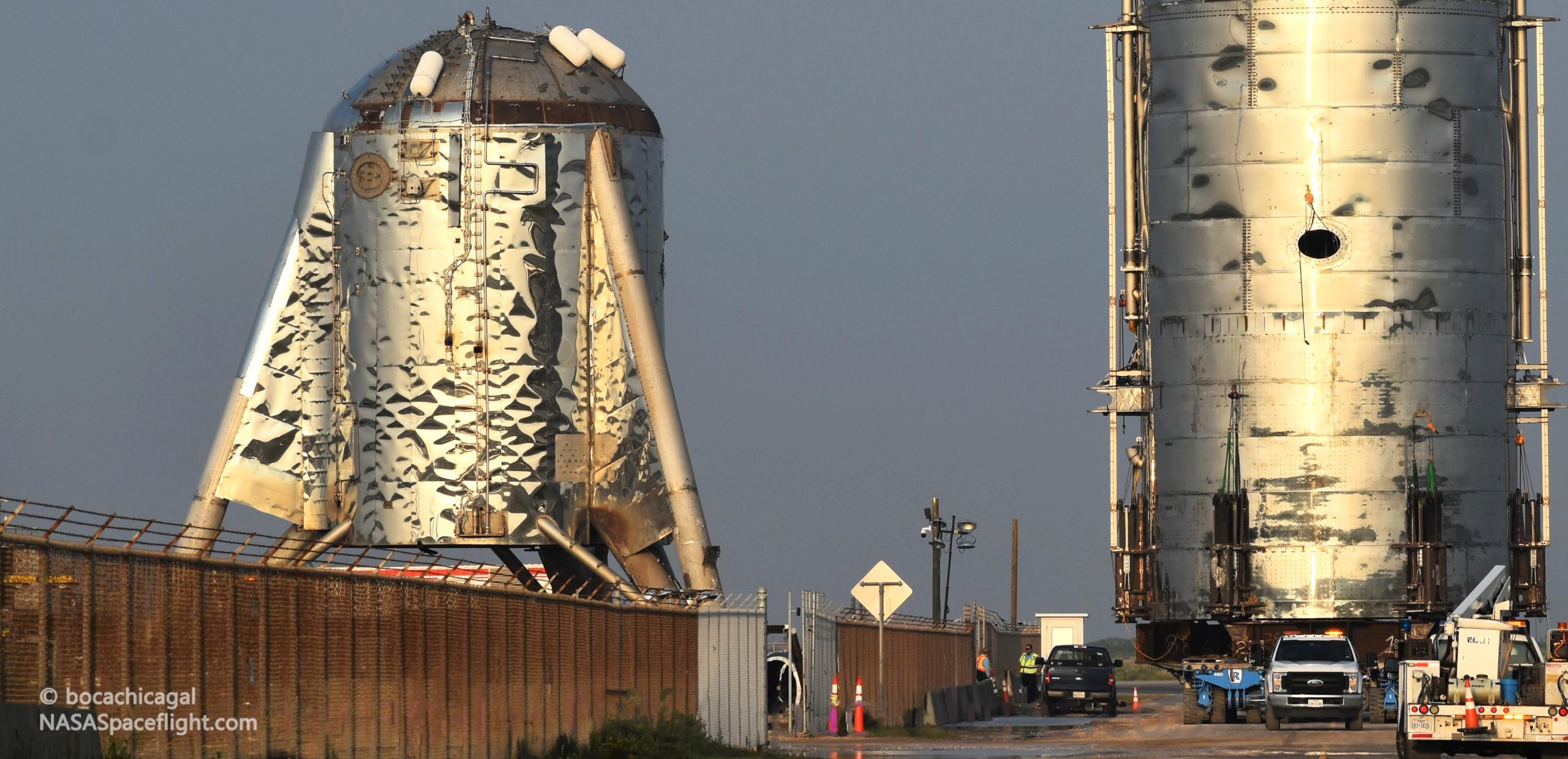
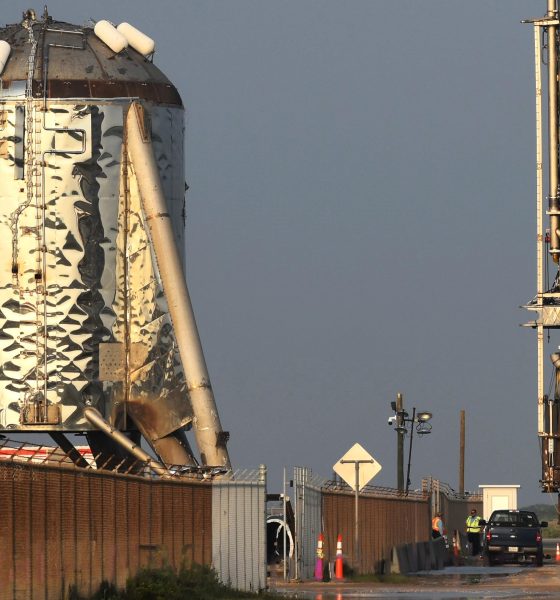
News
Elon Musk gifts SpaceX Starship angel investor a piece of Starhopper history
According to photos posted by the Japanese investor, SpaceX CEO Elon Musk has gifted Yusaku Maezawa a significant piece of Starhopper history, a celebration of the rocket prototype’s successful flight tests and a gesture of thanks for Maezawa’s substantial support.
Back in September 2018, Musk revealed that Japanese billionaire Yusaku Maezawa had become the first true customer for SpaceX’s next-generation Starship launch vehicle. In fact, Maezawa announced DearMoon, a private spaceflight venture with the aim of sending a dozen or so artists on the first commercial crewed mission around the Moon – all for free.
In a bid to assist Starship development and simultaneously secure rights to the massive spacecraft’s first crewed lunar launch, Maezawa committed what is believed to be several hundred million dollars of his personal fortune to SpaceX. In turn, the Japanese billionaire plans to select roughly a dozen artists from around the world and offering them a free ticket aboard Starship’s first crewed circumlunar launch, traveling once around the Moon and returning to Earth after 10 or so days in space.
Perhaps just a few weeks after the DearMoon announcement and Starship event, SpaceX CEO Elon Musk decided to radically change the Starship program, entirely replacing the vehicle’s main structural material of choice – carbon fiber composites – with stainless steel. The primary goal was to dramatically lower the cost of development and vehicle production and speed things up, but Musk quickly realized that steel could unintuitively be better than carbon fiber in almost every way.
After Musk’s decision, SpaceX pivoted from carbon fiber to steel at a spectacular pace. Barely six months after the design change, a SpaceX team had built up its Boca Chica, Texas facilities from almost nothing, begun to build full-scale steel hardware, and nearly completed the first low-fidelity prototype, known as Starhopper. That vehicle began propellant loading and wet dress rehearsal testing in early-April 2019 and although technical difficulties with its next-generation Raptor engines caused several months of delays, it moved into its first flight test campaign three months later.
Starhopper’s first untethered flight was completed successfully on July 25th, reaching an apogee of ~18 meters (60 ft). A little over one month later, Starhopper lifted off for the second time on a significantly more ambitious ~150m (500 ft) flight test, completed successfully after about 60 seconds in flight. That second test would be Starhopper’s last and SpaceX quickly turned its focus to completing the first full-scale, full-fidelity Starship prototypes, known as Mk1 (TX) and Mk2 (FL).
Throughout this process, Yusaku Maezawa has followed along with SpaceX. Rather than a simple lump-sum agreement, the billionaire’s contract with SpaceX is structured much more specifically, essentially allowing the company to unlock additional funding after certain milestones – like Starhopper’s flight tests – are completed. The arrangement is more of a carrot on a stick than something dead-serious – Maezawa is probably not going to completely withhold funding if SpaceX slightly misses exact targets or suffers anomalies during a complex launch vehicle development program.
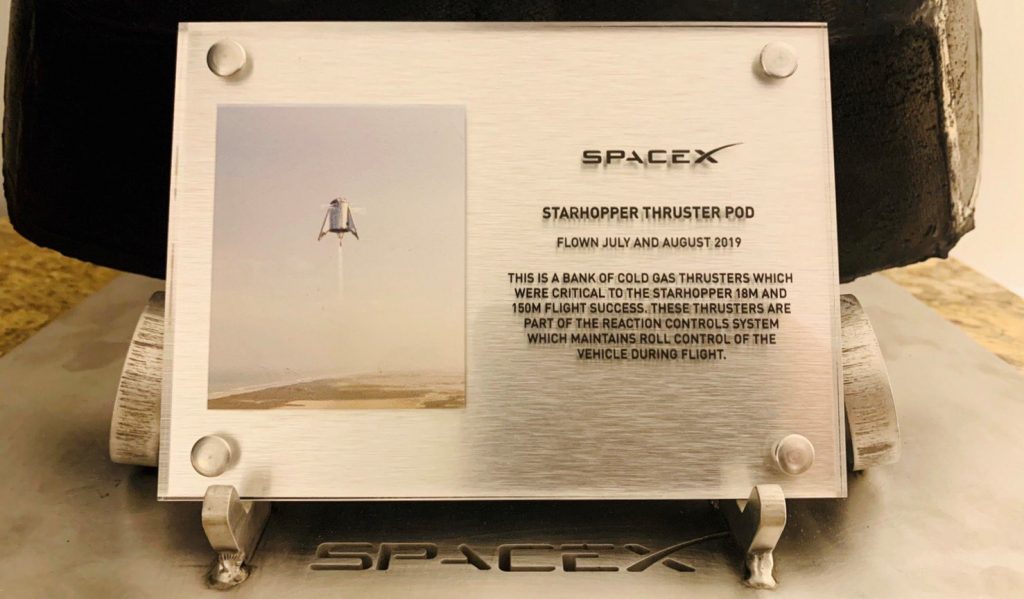
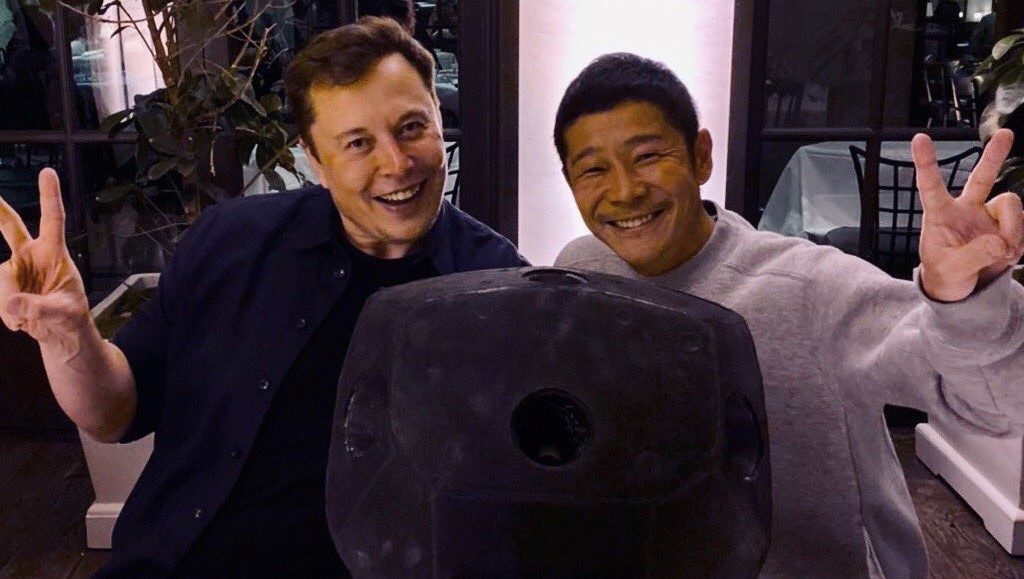
In order to complete its two flight tests, Starhopper needed some kind of attitude control system (ACS) to remain stable and SpaceX chose a decidedly SpaceX-y solution, simply bolting on flight-proven Falcon 9 thruster pods. Those pods use high-pressure nitrogen to change Falcon 9’s attitude, correctly point the rocket, and settle its propellant while the rocket is in a vacuum (or freefall). They can also provided limited control authority in atmosphere, which is what SpaceX used them for on Starhopper.
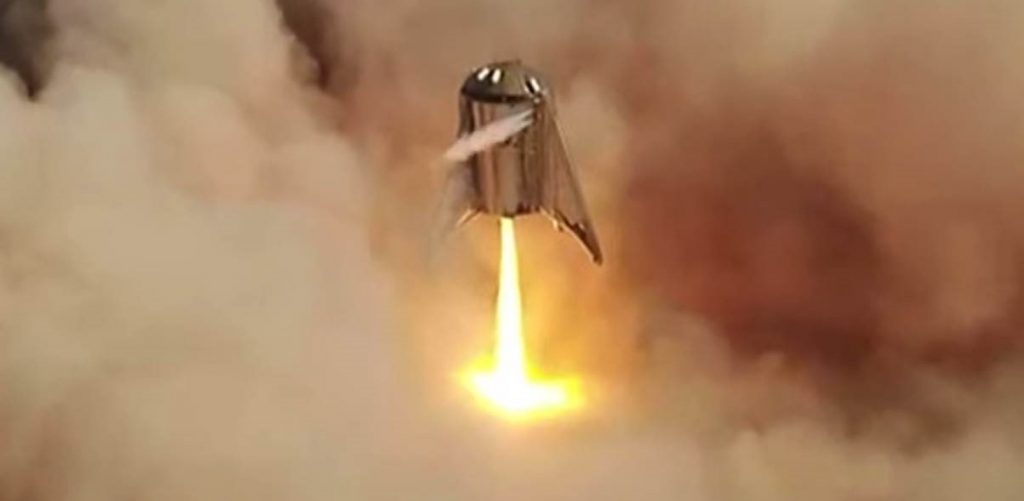
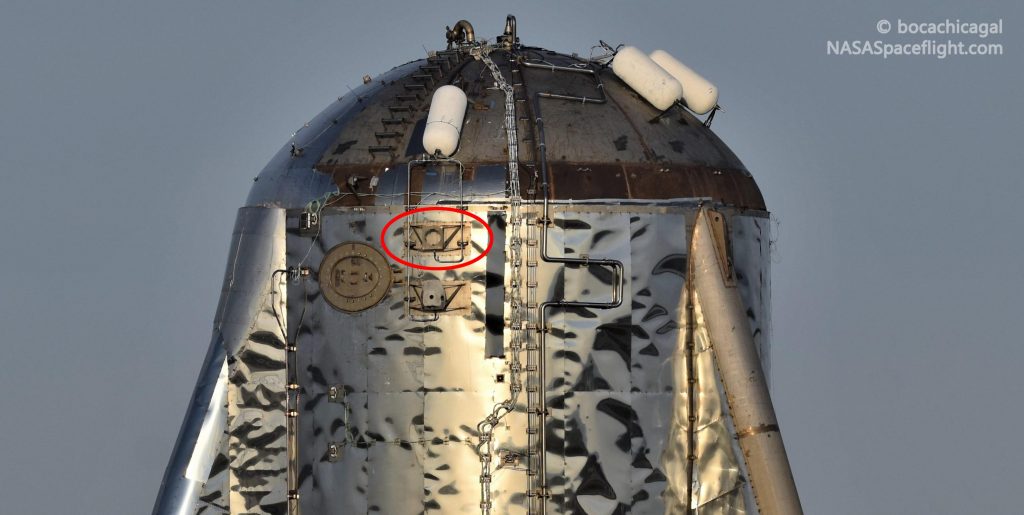
As a gesture of gratitude for Maezawa’s extremely helpful financial support, SpaceX gifted him an entire Starhopper thruster pod. SpaceX often does similar things for major flight milestones, creating commemorative gifts out of retired hardware (rocket tanks, engine bells, grid fins, parachute threads, etc.) that employees are able to purchase. An entire thruster pod is at least a few orders of magnitude above that, a sign of just how grateful SpaceX is to Maezawa.
Of note, in his tweet showing off the thruster pod, Maezawa suggested that “Starship development is going better than expected”, indicating that he may “need to invite a passenger soon” for his planned circumlunar voyage around the Moon. Prior to Starship’s radical shift from carbon fiber to steel, that mission was scheduled no earlier than 2023. In recent months, SpaceX executives have made it clear that they are now targeting Starship Moon landings by 2022, suggesting that the first circumlunar missions – a far easier task than landing – could be possible even sooner than that.
Check out Teslarati’s Marketplace! We offer Tesla accessories, including for the Tesla Cybertruck and Tesla Model 3.

News
Tesla starts showing how FSD will change lives in Europe
Local officials tested the system on narrow country roads and were impressed by FSD’s smooth, human-like driving, with some calling the service a game-changer for everyday life in areas that are far from urban centers.

Tesla has launched Europe’s first public shuttle service using Full Self-Driving (Supervised) in the rural Eifelkreis Bitburg-Prüm region of Germany, demonstrating how the technology can restore independence and mobility for people who struggle with limited transport options.
Local officials tested the system on narrow country roads and were impressed by FSD’s smooth, human-like driving, with some calling the service a game-changer for everyday life in areas that are far from urban centers.
Officials see real impact on rural residents
Arzfeld Mayor Johannes Kuhl and District Administrator Andreas Kruppert personally tested the Tesla shuttle service. This allowed them to see just how well FSD navigated winding lanes and rural roads confidently. Kruppert said, “Autonomous driving sounds like science fiction to many, but we simply see here that it works totally well in rural regions too.” Kuhl, for his part, also noted that FSD “feels like a very experienced driver.”
The pilot complements the area’s “Citizen Bus” program, which provides on-demand rides for elderly residents who can no longer drive themselves. Tesla Europe shared a video of a demonstration of the service, highlighting how FSD gives people their freedom back, even in places where public transport is not as prevalent.
What the Ministry for Economic Affairs and Transport says
Rhineland-Palatinate’s Minister Daniela Schmitt supported the project, praising the collaboration that made this “first of its kind in Europe” possible. As per the ministry, the rural rollout for the service shows FSD’s potential beyond major cities, and it delivers tangible benefits like grocery runs, doctor visits, and social connections for isolated residents.
“Reliable and flexible mobility is especially vital in rural areas. With the launch of a shuttle service using self-driving vehicles (FSD supervised) by Tesla in the Eifelkreis Bitburg-Prüm, an innovative pilot project is now getting underway that complements local community bus services. It is the first project of its kind in Europe.
“The result is a real gain for rural mobility: greater accessibility, more flexibility and tangible benefits for everyday life. A strong signal for innovation, cooperation and future-oriented mobility beyond urban centers,” the ministry wrote in a LinkedIn post.
News
Tesla China quietly posts Robotaxi-related job listing
Tesla China is currently seeking a Low Voltage Electrical Engineer to work on circuit board design for the company’s autonomous vehicles.

Tesla has posted a new job listing in Shanghai explicitly tied to its Robotaxi program, fueling speculation that the company is preparing to launch its dedicated autonomous ride-hailing service in China.
As noted in the listing, Tesla China is currently seeking a Low Voltage Electrical Engineer to work on circuit board design for the company’s autonomous vehicles.
Robotaxi-specific role
The listing, which was shared on social media platform X by industry watcher @tslaming, suggested that Tesla China is looking to fill the role urgently. The job listing itself specifically mentions that the person hired for the role will be working on the Low Voltage Hardware team, which would design the circuit boards that would serve as the nervous system of the Robotaxi.
Key tasks for the role, as indicated in the job listing, include collaboration with PCB layout, firmware, mechanical, program management, and validation teams, among other responsibilities. The role is based in Shanghai.
China Robotaxi launch
China represents a massive potential market for robotaxis, with its dense urban centers and supportive policies in select cities. Tesla has limited permission to roll out FSD in the country, though despite this, its vehicles have been hailed as among the best in the market when it comes to autonomous features. So far, at least, it appears that China supports Tesla’s FSD and Robotaxi rollout.
This was hinted at in November, when Tesla brought the Cybercab to the 8th China International Import Expo (CIIE) in Shanghai, marking the first time that the autonomous two-seater was brought to the Asia-Pacific region. The vehicle, despite not having a release date in China, received a significant amount of interest among the event’s attendees.
Elon Musk
Elon Musk and Tesla AI Director share insights after empty driver seat Robotaxi rides
The executives’ unoccupied tests hint at the rapid progress of Tesla’s unsupervised Robotaxi efforts.

Tesla CEO Elon Musk and AI Director Ashok Elluswamy celebrated Christmas Eve by sharing personal experiences with Robotaxi vehicles that had no safety monitor or occupant in the driver’s seat. Musk described the system’s “perfect driving” around Austin, while Elluswamy posted video from the back seat, calling it “an amazing experience.”
The executives’ unoccupied tests hint at the rapid progress of Tesla’s unsupervised Robotaxi efforts.
Elon and Ashok’s firsthand Robotaxi insights
Prior to Musk and the Tesla AI Director’s posts, sightings of unmanned Teslas navigating public roads were widely shared on social media. One such vehicle was spotted in Austin, Texas, which Elon Musk acknowleged by stating that “Testing is underway with no occupants in the car.”
Based on his Christmas Eve post, Musk seemed to have tested an unmanned Tesla himself. “A Tesla with no safety monitor in the car and me sitting in the passenger seat took me all around Austin on Sunday with perfect driving,” Musk wrote in his post.
Elluswamy responded with a 2-minute video showing himself in the rear of an unmanned Tesla. The video featured the vehicle’s empty front seats, as well as its smooth handling through real-world traffic. He captioned his video with the words, “It’s an amazing experience!”
Towards Unsupervised operations
During an xAI Hackathon earlier this month, Elon Musk mentioned that Tesla owed be removing Safety Monitors from its Robotaxis in Austin in just three weeks. “Unsupervised is pretty much solved at this point. So there will be Tesla Robotaxis operating in Austin with no one in them. Not even anyone in the passenger seat in about three weeks,” he said. Musk echoed similar estimates at the 2025 Annual Shareholder Meeting and the Q3 2025 earnings call.
Considering the insights that were posted Musk and Elluswamy, it does appear that Tesla is working hard towards operating its Robotaxis with no safety monitors. This is quite impressive considering that the service was launched just earlier this year.








